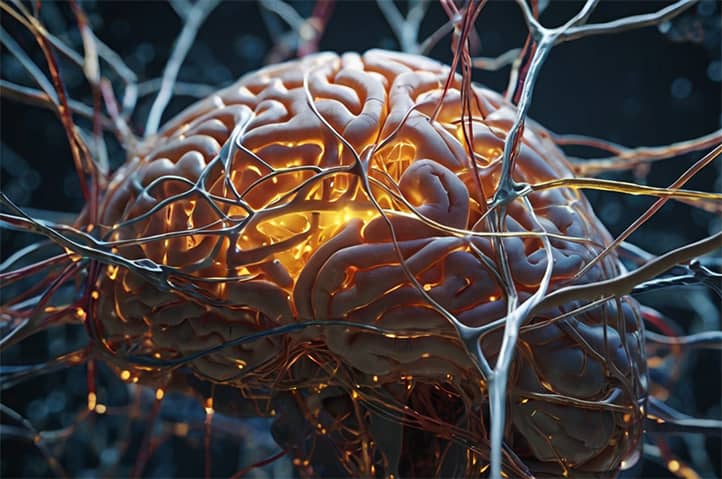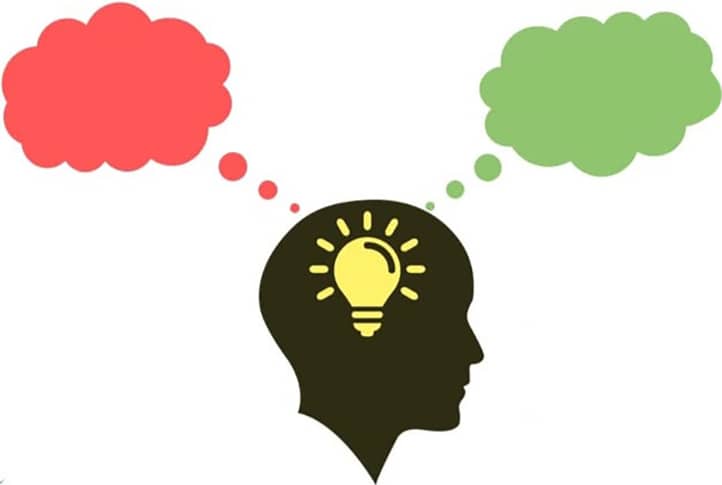Associative thinking is a cognitive process that enables the establishment of connections between various ideas, concepts, memories, or sensations. It is based on the brain’s ability to create neural links that associate one concept with another. For example, the word “summer” might evoke an image of the sea, the smell of flowers, or memories of a vacation.
This type of thinking allows the brain to work not only linearly but also creatively and multidimensionally. Through associations, we can understand metaphors, create new ideas, and solve complex problems. Associative thinking forms the basis of creativity, intuition, and the ability to adapt to new conditions.
Associative thinking permeates all aspects of our lives, often without our conscious awareness.
- Perception of the world. Associations help us understand complex phenomena. For instance, new knowledge is easier to grasp when linked to something already familiar to us.
- Communication. In conversations, people often use metaphors, jokes, or comparisons based on associative links. For example, the phrase “life is like a zebra” conjures the image of alternating black and white stripes—difficulties and joyful moments.
- Emotional reactions. Associations shape our emotional attachments. A favorite song may remind us of happy moments, while the smell of coffee might evoke a cozy morning.
- Problem-solving. Associative thinking allows us to find unexpected answers to questions, create innovations, and invent. For instance, the idea for Velcro fasteners emerged from observing how burdock burrs stick to fabric.
Thus, associations are an integral part of thinking, making our daily lives easier and richer.
In today’s world, associative thinking has become especially important for several reasons:
- Rapid changes in the information environment. We live in an era where information is constantly updated. To process data effectively, one must not merely memorize facts but also establish connections between them. Associative thinking helps structure large volumes of information and identify key patterns.
- Creativity and innovation. The modern labor market demands non-standard solutions and innovative approaches. Associative thinking becomes a tool for generating new ideas that transcend traditional thinking.
- Psychological well-being. In psychological practice, associative thinking is used to work with emotions, traumas, and internal conflicts. For example, the method of free associations in psychoanalysis helps uncover hidden aspects of a person’s personality.
- Personal development. Associative thinking fosters a deeper understanding of oneself and the world. It aids individuals in becoming more aware of their desires, fears, and values.
Considering this, studying associative thinking is crucial not only for psychology but also for education, business, and science. Understanding its mechanisms enables individuals to better adapt to modern challenges and develop their potential.

Associative Thinking: Foundations and Nature
Associative thinking is a fundamental aspect of human cognition, enabling the establishment of connections between concepts, ideas, images, and memories. This type of thinking relies on the brain’s natural ability to form associative links, which act as “bridges” between various neural groups. Through associations, we can rapidly process information, generate new ideas, and even predict potential outcomes.
The nature of associative thinking is closely tied to brain function, particularly the principles governing neural connections. It also relies on universal psychological principles such as similarity, contrast, and contiguity. Understanding these mechanisms explains why certain ideas or images easily connect and how individuals perceive and interpret the world around them.
Associative thinking is an indispensable tool in creative activities, learning, decision-making, and communication. Developing this ability allows individuals to deepen their understanding of thought processes, promoting personal growth and better adaptation to a rapidly changing world.
How the Brain Works: The Principle of Neural Connections
The brain comprises billions of neurons interacting through specialized contacts called synapses. When we encounter new information or recall something familiar, connections between neurons form, creating a network.
- Formation of Associations: Each new experience leaves a trace in the brain as a neural pathway. Repeated experiences strengthen these pathways, forming robust associative links. For instance, the smell of rain might remind someone of childhood walks.
- Brain Plasticity: One of the brain’s key features is neuroplasticity—the ability to change the structure of neural connections based on experience. This property allows the formation of new associations throughout life.
- Processing Speed: Thanks to associative links, the brain processes information quickly. For example, seeing a red traffic light instantly triggers the association with “stop.”
The principle of neural connections provides a foundation for understanding how the brain creates and uses associations to process information.
Key Principles of Associations
Associative thinking operates on three core principles that determine how information is linked:
- Similarity: Connections are formed between objects or concepts with shared characteristics. For instance, the words “summer” and “sun” are associated due to their close semantic relationship.
- Contrast: Associations can also arise from opposites. For example, day is linked to night, and cold to warmth. Contrast helps the brain structure information by emphasizing extremes.
- Contiguity: This principle is based on the temporal or spatial proximity of objects. For example, the scent of flowers might be associated with a particular place or season where the scent was experienced.
Understanding these principles sheds light on how we create meaningful links between objects and how this influences thought and memory.
The Impact of Associative Thinking on Information Perception
Associative thinking significantly facilitates the processes of perceiving and processing information:
- Easier Memorization: New information is easier to remember when connected to familiar concepts. For example, learning a new language often involves associating unfamiliar words with native ones.
- Quick Decision-Making: Associations enable instant situation evaluation. For instance, a familiar alarm sound is linked to danger, prompting a swift reaction.
- Creativity: In creative endeavors, associative thinking helps combine seemingly incompatible ideas. For example, Leonardo da Vinci studied bird flight to conceptualize flying machines.
Thus, associative thinking is a key mechanism influencing how we perceive, remember, and utilize information in various aspects of life.

Scientific Foundations of Associative Thinking
Associative thinking is a critical component of human cognition and has been the subject of extensive research in psychology and neuroscience. This process is rooted in the brain’s ability to form connections between ideas, images, or concepts using neural networks. Scientific approaches not only describe how associative thinking works but also uncover its role in memory, learning, creativity, and decision-making.
Neuropsychological studies reveal that forming associations relies on complex neural processes, such as activating specific brain regions and strengthening synapses. Experience and memory play vital roles in building associative chains: prior knowledge is always used to interpret new phenomena or connections. Modern technologies like functional magnetic resonance imaging (fMRI) have enabled scientists to visualize the process of creating associations in the brain.
Understanding these mechanisms has practical significance. It allows for developing effective teaching methods, therapies to improve memory, and even artificial intelligence capable of mimicking human cognitive processes.
Neuropsychological Studies: How Associations Form
Neuropsychological research demonstrates that associative thinking is based on the activity of neural networks in the brain:
- Neuron Activity: Associations arise from the simultaneous activation of neurons in different brain areas. For example, seeing an apple activates zones responsible for vision, taste, smell, and memories linked to the fruit.
- The Role of the Hippocampus: The hippocampus, a brain structure, plays a central role in forming associations. It stores information as “codes,” enabling connections between events or objects.
- Synaptic Plasticity: When neurons activate together, the synapses between them strengthen. This phenomenon, known as Hebb’s Law—”neurons that fire together wire together”—forms the basis of durable associations.
- Emotional Influence: Studies show that emotions greatly enhance association formation. For instance, traumatic events linked to strong emotions are retained in memory for a long time.
These discoveries illuminate how the brain creates connections between elements of information and explain individual differences in associative thinking.
The Role of Memory and Experience in Building Associative Chains
Memory and experience are the foundation of associative thinking:
- Long-Term Memory: Memories stored in long-term memory serve as the base for creating new associations. For example, someone who spent their childhood by the sea will associate the sound of waves with pleasant memories.
- Short-Term Memory: Short-term memory helps form temporary associations that may fade unless reinforced through repetition. For instance, when learning a new language, words are memorized by linking them to native equivalents.
- The Role of Experience: Personal experience influences the types of associations that form. The same object can evoke different associations in different individuals, depending on their life stories.
- Context: Associations form in specific contexts, which add meaning. For example, the word “warmth” might evoke thoughts of the sun or a blanket, depending on the situation.
Thus, memory and experience are vital resources that determine how associations form, their strength, and their durability.
Examples from Real Research
- The Experiment with Scents and Memory. In a study conducted by Rachel Herz, participants were asked to recall specific events based on smells. It was found that scents evoke the most vivid and emotionally charged memories as they are closely linked to the functioning of the limbic system.
- The Associative Creativity Test. Guilford’s research demonstrated that individuals with high associative creativity can find unexpected connections between concepts. For example, in an association task, participants were asked to find a connection between the words “snow,” “white,” and “ice cream.” The answer — “cold” — showcased the ability to establish abstract links.
- Neuroimaging of Creative Thinking. Using fMRI, researchers observed brain activation during creative tasks. It was revealed that forming associations activates the prefrontal cortex and frontal lobes, responsible for complex thinking.
These examples illustrate how associative thinking operates in practice and highlight its importance for creativity, memory, and learning.

The Magic of Neural Connections in Psychology
Associative thinking has a unique property: it not only helps process information but also actively influences emotions and behavior. Neural connections formed as a result of this thinking serve as the foundation for our reactions, habits, and even personal beliefs. In psychology, associations are used as tools to understand the deep mechanisms of the human psyche and assist individuals in overcoming stress, anxiety, and other challenges.
Researchers and therapists have long recognized how associations can both aid and hinder daily life. Negative associations formed due to traumatic events can lead to anxiety disorders, while positive connections can support mental stability and improve overall well-being. Using associative techniques in therapy is a powerful way to reshape thought patterns and promote emotional healing.
How Associations Influence Emotions and Behavior?
Associations play a significant role in how we feel and respond to the world around us.
- Formation of Emotional Connections. Emotions often arise as a result of associations between objects or events. For example, the smell of freshly baked bread may evoke a sense of comfort as it is associated with childhood. Conversely, the sound of a siren may provoke anxiety due to its association with danger.
- Associative Reinforcement of Behavior. Behavior is often reinforced through associations. For instance, if a person receives praise for their actions, they associate that behavior with positive emotions, motivating them to repeat it.
- Negative Associations. Negative emotions can also result from associations. For example, certain music may evoke sadness due to its connection with an unpleasant event. Such associations can lead to fears or even phobias.
Thus, emotions and behavior are deeply integrated with associative thinking, making this mechanism a vital subject of psychological research.
Using Associative Thinking in Psychotherapy
Psychotherapeutic methods often rely on working with associations that influence a person’s thinking and emotional state.
- Art Therapy. This method uses creativity to form new positive associations. For example, drawing or sculpting helps individuals express their emotions and reinterpret traumatic experiences. The creative process allows for replacing negative associations with positive ones, fostering healing.
- Cognitive Behavioral Therapy (CBT) addresses beliefs arising from negative associations. For instance, if a patient has a fear of public speaking, the therapist helps replace the negative association (“I will embarrass myself”) with a neutral or positive one (“I can perform well”). This process includes exercises that gradually change the brain’s response to triggers.
- Trauma Work. In PTSD therapy, techniques are aimed at forming new associations. For example, Eye Movement Desensitization and Reprocessing (EMDR) helps the brain reprocess traumatic events.
Through these methods, therapists can actively influence associative chains, enabling significant progress in treating emotional disorders.
Associative Techniques for Reducing Anxiety and Stress
Associative thinking is also applied in practical techniques aimed at reducing stress and anxiety.
- Visualization. The visualization method involves creating positive associations through imagination. For instance, a person imagines themselves on a beach, associating it with a sense of calm. This helps lower anxiety in stressful situations.
- Meditation and Mindfulness Techniques. Mindfulness practices help form associations between the feeling of being “here and now” and tranquility. Regular meditation practice allows creating a link between deep breathing (e.g., the “box breathing” method) and relaxation.
- Reframing. This technique helps change the perception of a situation by creating new associations. For example, instead of thinking, “I failed the task,” one can form a new association: “This was a lesson that will help me improve.”
- Music Therapy. Music can evoke strong associations. Using specific sounds or melodies helps calm the nervous system and create a sense of safety.
Thus, associative techniques are an effective way to reduce stress and anxiety. They not only help overcome challenging emotions but also build resilience to future stressful situations.

Developing Associative Thinking
Associative thinking is the brain’s ability to identify connections between different ideas, images, or concepts. While it is a natural brain function, this skill can be intentionally developed, unlocking vast opportunities for creativity, problem-solving, and improving cognitive abilities. Regular training of associative thinking enhances mental flexibility, improves memory, and facilitates faster adaptation to new conditions.
In today’s world, where information flows are growing daily, the ability to quickly and effectively establish connections between pieces of information has become one of the key skills. Associative thinking not only helps retain knowledge but also creatively apply it in new situations.
Methods and Exercises to Train the Brain
Developing associative thinking is achievable through exercises that stimulate the brain to search for connections and expand the boundaries of thought.
Free Association
The free association method is based on quickly finding connections between different words or images.
How to perform the exercise:
- Choose a word (e.g., “tree”).
- For 1-2 minutes, write down all the words that come to mind in connection with this concept (e.g., leaves, branch, nature, green).
- Do not analyze or judge the ideas; let your thinking flow spontaneously.
Benefits:
This exercise activates imagination, reduces blocks related to evaluative thinking, and enhances the ability to think outside the box.
Creating Mind Maps
Mind maps are a graphic way of structuring information based on associations.
How to create a mind map:
- Write the main word or idea in the center of the page (e.g., “project”).
- Add branches that represent subtopics (e.g., “resources,” “team”).
- For each subtopic, add new branches with details (e.g., “resources” → “financial,” “technical”).
Benefits:
Mind maps help organize thoughts, discover new ideas, and establish unexpected connections between concepts.
Creative Tasks and Games
Playing games develops the brain and stimulates it to find new connections.
Examples of games and tasks:
- “Third Word”: Choose two random words (e.g., “sea” and “stone”) and come up with a third word that connects them (e.g., “beach”).
- “What’s in Common?”: Find similarities between seemingly unrelated objects (e.g., “lamp” and “electricity” → “light”).
- “Create a Story”: Use five random words to craft a short story.
Benefits:
These games stimulate thinking, foster imagination, and help identify non-obvious connections.
The Impact of Meditation and Mindfulness Practices
Meditation and mindfulness practices positively affect cognitive abilities, including associative thinking.
- Meditation as a way to expand consciousness helps relax the mind and open it to new ideas. During deep relaxation, the brain operates in a more flexible mode, encouraging the formation of unconventional connections between thoughts. For instance, during meditation, one might unexpectedly find a solution to a problem they have been pondering for a long time.
- Mindfulness techniques focus attention on the present moment, helping to notice small details and establish connections between them. For example, during a mindful walk, one can pay attention to sounds, smells, and sensations, which fosters the creation of new associations.
Neuropsychological studies show that regular meditation increases gray matter density in the prefrontal cortex, responsible for creative thinking. It also reduces anxiety levels, easing brain activity and promoting the development of associative thinking.
Practical exercises:
- Meditation “Stream of Thoughts”: Sit comfortably, relax, and let your thoughts flow freely. Observe which associations arise without interfering in the process.
- Gratitude Practice: Each evening, write down three things you are grateful for. This helps cultivate positive thinking and discover associations that contribute to emotional stability.
Developing associative thinking is an essential tool for enhancing cognitive abilities, creativity, and adaptability to new challenges. By employing exercises, creative games, and meditation practices, anyone can significantly improve their ability to find connections between ideas and apply them in life. This not only opens new horizons for personal growth but also helps uncover unique solutions in complex situations.

Practical Application of Associative Thinking
Associative thinking is a universal tool that finds application in many aspects of our lives. It helps solve complex problems, establish communication with others, and quickly absorb new knowledge. Thanks to the brain’s ability to establish connections between seemingly unrelated concepts, we can creatively approach problem-solving and better understand the surrounding world.
In modern society, where creativity and the ability to adapt to changes are increasingly valued, developing associative thinking becomes extremely relevant. It aids in seeking unconventional solutions, improves the quality of learning, and promotes better mutual understanding among people.
In Professional Life
Associative thinking is an integral part of successful professional activity, especially in fields that require creativity and quick decision-making.
- Problem-Solving. In many professions, people face complex situations requiring a creative approach. Associative thinking helps quickly analyze a problem and find a solution by combining knowledge from various fields. In business, using associations can help address tasks related to improving team efficiency, exploring new markets, or creating innovative products.
- Idea Generation. The brainstorming method widely used in business is based on associative thinking. When participants express their ideas, it creates a chain reaction where each new idea stimulates the generation of the next.
Example: In a company developing eco-friendly packaging, designers relied on associations with nature. This allowed them to create an innovative product inspired by leaf structures, which is both durable and biodegradable.
In Interpersonal Communication
Associative thinking fosters better understanding of others by enabling connections between their words, emotions, and the context of the situation.
- Developing Empathy. When communicating with another person, associative thinking helps imagine their emotional state or experiences. For example, if someone shares their stress at work, associative thinking allows us to recall a similar situation from our experience and better understand their feelings.
- Understanding Nonverbal Signals. Associations between facial expressions, gestures, and voice tone help “read” people better. For instance, if a conversation partner smiles but their tone sounds tense, we might conclude that they are experiencing hidden stress.
- Application in Conflict Situations. In conflicts, associative thinking can be a tool for finding common ground.
Example: In psychological counseling, associative thinking helps the psychologist identify connections between what the client says and how they behave, providing deeper insights into their experiences.
In Learning and Self-Development: How to Effectively Absorb New Information
Associative thinking significantly enhances the learning process by linking new information with existing knowledge.
- Associative Memorization Method. To remember a new term, it can be associated with an image or situation. For example, the word “neuron” can be imagined as a tree branch connecting to other branches (like neurons in the brain).
- Creativity Development. In the learning process, it is important not only to memorize facts but also to creatively use them. Associative techniques allow generating new ideas based on already learned material.
Effective Methods:
- Mnemonic Devices. Creating associations to remember large amounts of information. For instance, to memorize the order of rainbow colors (red, orange, yellow, green, blue, indigo, violet), one might use the phrase: “Richard Of York Gave Battle In Vain.”
- Interactive Learning. Using games and interactive exercises to establish connections between theory and practice.
Example: Students studying languages can associate new words with images or events, making the learning process more engaging and effective.
The practical application of associative thinking is extremely diverse. In professional life, it helps solve problems and create innovations. In interpersonal communication, it fosters better understanding of others and building connections. In learning and self-development, it enables more effective information absorption and creative use. By developing associative thinking, we unlock new opportunities for success in various aspects of life.

Conclusion
Associative thinking is a fundamental mechanism that defines our perception of the world, information processing, and decision-making. It forms the basis of creativity, innovation, and adaptability, making it extremely important in both everyday life and professional activities. Understanding the principles of associative thinking, such as forming connections between ideas through similarity, contrast, or contiguity, allows us to use this tool to its fullest potential.
Developing associative thinking unveils vast potential for personal growth. It contributes to deeper self-awareness, enhances creativity, and helps find unconventional solutions in challenging situations. Success in the professional sphere increasingly depends on the ability to generate innovative ideas, effectively solve problems, and quickly adapt to changes. Associative thinking is the tool that makes these processes possible and enables us to explore new horizons for development.
Moreover, it plays a key role in building quality interpersonal relationships. The ability to understand others’ emotions and behavior through associative connections increases empathy and facilitates communication. This not only promotes harmonious relationships but also enhances teamwork and the development of social skills.
Recommended Reading
- Freud, S. “The Psychopathology of Everyday Life.” In this work, Sigmund Freud examines the role of associations in psychoanalysis, particularly in connection with subconscious processes.
- Bocharova, S.P. “Psychology of Memory: Theory and Practice for Learning and Work.” The book is devoted to cognitive processes, including memorization, information processing, and associative thinking.
- Damasio, A. “Feelings and Knowledge: The Path to a Conscious Mind.” A work highlighting the connection between emotions, cognition, and neural mechanisms that form associations.




